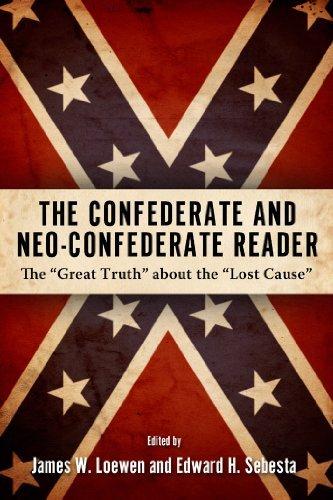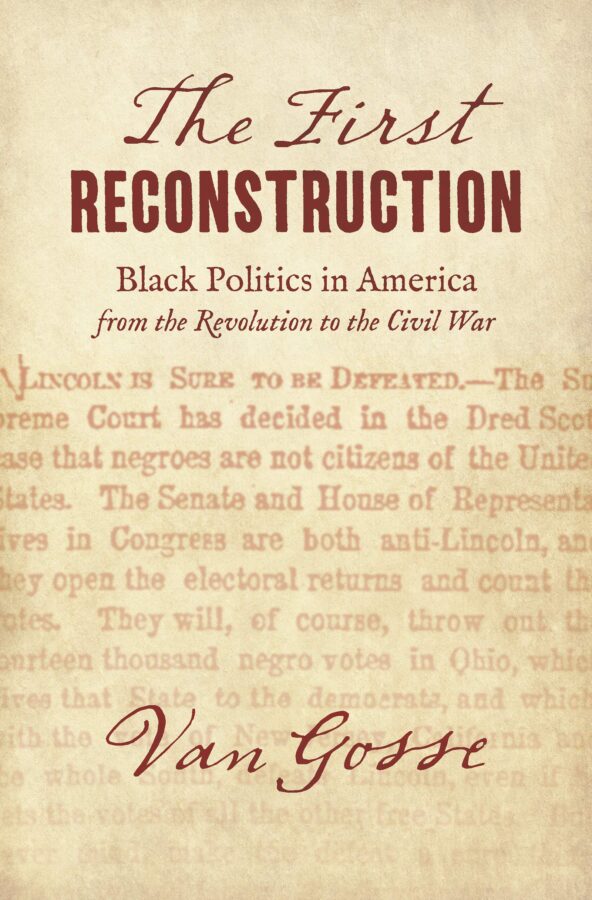The Confederate and Neo-Confederate Reader: The Great Truth about the Lost Cause edited by James Loewen and Edward Sebesta. The University Press of Mississippi, 2010. Paper, ISBN: 1604732199. $25.00.
 The great mnemonic power of the Lost Cause of the Confederacy has been in its ability to uphold almost all of the original tenets of its long-standing mythologies (the war was not about slavery, most slaveholders were benevolent, the Confederacy fought for states’ rights, Confederate heroes are above reproach, etc.) of the Civil War and the Confederacy throughout the last 150 years. For those of us that study and teach issues of Civil War memory, one of our great frustrations has been the lack of easily attainable primary source material to thoroughly discredit and dismantle the mythological claims of Confederate and neo-Confederate revisionists. Loewen and Sebesta’s exceptional new text The Confederate and Neo-Confederate Reader is the first collection of primary sources focused exclusively on such documents, as the authors note, that have somehow remained hidden “in plain sight” since the end of the Civil War. The book provides teachers and researchers alike with an invaluable archive of speeches, images, political papers, and memoirs that graphically reveal what the Confederacy and its post-war nostalgists actually believed about slavery, secession, race relations, and the whitewashing of the southern past.
The great mnemonic power of the Lost Cause of the Confederacy has been in its ability to uphold almost all of the original tenets of its long-standing mythologies (the war was not about slavery, most slaveholders were benevolent, the Confederacy fought for states’ rights, Confederate heroes are above reproach, etc.) of the Civil War and the Confederacy throughout the last 150 years. For those of us that study and teach issues of Civil War memory, one of our great frustrations has been the lack of easily attainable primary source material to thoroughly discredit and dismantle the mythological claims of Confederate and neo-Confederate revisionists. Loewen and Sebesta’s exceptional new text The Confederate and Neo-Confederate Reader is the first collection of primary sources focused exclusively on such documents, as the authors note, that have somehow remained hidden “in plain sight” since the end of the Civil War. The book provides teachers and researchers alike with an invaluable archive of speeches, images, political papers, and memoirs that graphically reveal what the Confederacy and its post-war nostalgists actually believed about slavery, secession, race relations, and the whitewashing of the southern past.
The Confederate and Neo-Confederate Reader begins with a wonderful introduction to the source material in the book and a useful discussion of what drew the editors to engage in such a project. As they quite correctly note, contemporary history textbooks have moved away from including direct quotations and documentary evidence in favor of often simplified and watered down summaries of key events from the American past. Additionally, textbook authors have often self-censored criticism of the Confederacy in order to get their books adopted by school boards within the South. Contemporary battles over textbooks and memory continue in many southern localities, as my home state of Virginia made headlines in 2010 for adopting a textbook for fourth graders claiming that thousands of African Americans fought willingly for the Confederacy during the war. This blatantly false claim was “supported” with “evidence” from online sources supplied by neo-Confederate websites. Incidents such as this make the need for a comprehensive archival textbook focused on eviscerating Lost Cause mythology all the more prescient.
For neo-Confederates and their supporters, the most damning and powerful feature of The Confederate and Neo-Confederate Reader is that the included documents allow Confederate heroes and politicians to speak for themselves about the war and secession without any contemporary filtering or editing. Though the authors introduce each entry with necessary context, the words and images found within the text speak for themselves. For example, the first three chapters include multiple examples of southern politicians including Jefferson Davis, John C. Calhoun, and Alexander Stephens stating explicitly that secession was about one thing: sustaining the slave system and the racial codes of the American South. Conspicuously absent from these past speeches and communiqués from southern leaders are discussions of the political issues neo-Confederates continue to suggest were the “real” reasons for secession such as federal taxation and tariffs and states’ rights. In one of the true revelations found in the collection, the editors uncovered a whole range of documents that suggest southern political leaders actually supported a stronger federal government prior to secession as a way of enforcing the legality of the slave system and limiting the perceived power of the abolitionist movement. Additionally, the Confederate Constitution is included, noting that the one of the few mentions of states’ rights in the document is in its Preamble. By contrast, the rest of the document reveals the intention of creating a strong centralized government modeled after the very federal government they seceded from.
Additionally, the reader includes a whole range of documentary evidence of the blatant racism and pro-slavery perspectives of southern leaders since the mid-nineteenth century. Chapter Three, for example, includes multiples speeches and letters from Jefferson Davis and Alexander Stephens in which both men advocate a southern society organized on the principle of white supremacy and the continuation of the slave system. Some of the most intriguing documents in the collection are found in Chapter Four, as the letters and speeches of former Confederate generals reveal both the blatant racism of many of these “heroes” and their compliancy in the development of Jim Crow era segregation and racist violence. For example, two letters written by Robert E. Lee reveal him to be far different than the benevolent post-war unifier that Lost Cause mythology has long purported. Rather, in the included White Sulphur Manifesto (1868), Lee advocates a position to allow the southern states to reinstitute the racial codes of the pre-war period for the sake of “peace” and “tranquility” in the region. As Loewen and Sebesta astutely note, Lee positions himself as a significant and powerful advocate for policies “condemning African Americans to a century of racial discrimination and violence” (254).
The final two chapters focus mainly on twentieth century documents, as Loewen and Sebesta include extensive evidence of the blatant racism and historical (mis)remembering within the emerging Lost Cause and neo-Confederate movements. These chapters should not be overlooked by history teachers using this textbook, as they provide sharp insight into how Lost Cause mythology became “truth” for many white Southerners and neo-Confederates during the postwar period. These chapters include useful documents from heritage organizations such as the United Daughters of the Confederacy (UDC) and the Sons of Confederate Veterans (SCV), supporting recent scholarship noting the significant roles the membership of these groups have played in constructing and sustaining the Lost Cause. Additionally, contemporary documents focused on issues of Confederate heritage displays (the flag, Confederate history month, and even t-shirt designs) provide teachers an opportunity to discuss these contemporary issues of heritage and race in their classrooms. It is my hope that this book will become widely used by secondary and university teachers in their American history and American studies courses. I thank the editors for finally bringing such a compelling collection to press.
Jon D. Bohland is an Assistant Professor of Political Science and International Studies at Hollins University.
